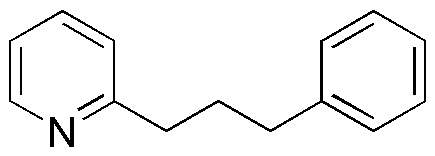2-(3-Phenylpropyl)pyridine is widely utilized in research focused on:
- Pharmaceutical Development: This compound serves as a key intermediate in the synthesis of various pharmaceuticals, particularly those targeting neurological disorders, enhancing drug efficacy and specificity.
- Agrochemical Formulations: It is used in developing agrochemicals, providing effective solutions for pest control while minimizing environmental impact, making it a preferred choice in sustainable agriculture.
- Material Science: The compound is incorporated into polymer formulations, improving the mechanical properties and thermal stability of materials, which is crucial for industries like automotive and construction.
- Flavor and Fragrance Industry: Its unique aromatic profile allows it to be used in creating complex fragrances and flavorings, appealing to manufacturers of perfumes and food products.
- Research Applications: In academic and industrial research, it is utilized as a building block for synthesizing novel compounds, facilitating advancements in chemical research and innovation.
General Information
Properties
Safety and Regulations
Applications
2-(3-Phenylpropyl)pyridine is widely utilized in research focused on:
- Pharmaceutical Development: This compound serves as a key intermediate in the synthesis of various pharmaceuticals, particularly those targeting neurological disorders, enhancing drug efficacy and specificity.
- Agrochemical Formulations: It is used in developing agrochemicals, providing effective solutions for pest control while minimizing environmental impact, making it a preferred choice in sustainable agriculture.
- Material Science: The compound is incorporated into polymer formulations, improving the mechanical properties and thermal stability of materials, which is crucial for industries like automotive and construction.
- Flavor and Fragrance Industry: Its unique aromatic profile allows it to be used in creating complex fragrances and flavorings, appealing to manufacturers of perfumes and food products.
- Research Applications: In academic and industrial research, it is utilized as a building block for synthesizing novel compounds, facilitating advancements in chemical research and innovation.
Documents
Safety Data Sheets (SDS)
The SDS provides comprehensive safety information on handling, storage, and disposal of the product.
Product Specification (PS)
The PS provides a comprehensive breakdown of the product’s properties, including chemical composition, physical state, purity, and storage requirements. It also details acceptable quality ranges and the product's intended applications.
Certificates of Analysis (COA)
Search for Certificates of Analysis (COA) by entering the products Lot Number. Lot and Batch Numbers can be found on a product’s label following the words ‘Lot’ or ‘Batch’.
*Catalog Number
*Lot Number
Certificates Of Origin (COO)
This COO confirms the country where the product was manufactured, and also details the materials and components used in it and whether it is derived from natural, synthetic, or other specific sources. This certificate may be required for customs, trade, and regulatory compliance.
*Catalog Number
*Lot Number
Safety Data Sheets (SDS)
The SDS provides comprehensive safety information on handling, storage, and disposal of the product.
DownloadProduct Specification (PS)
The PS provides a comprehensive breakdown of the product’s properties, including chemical composition, physical state, purity, and storage requirements. It also details acceptable quality ranges and the product's intended applications.
DownloadCertificates of Analysis (COA)
Search for Certificates of Analysis (COA) by entering the products Lot Number. Lot and Batch Numbers can be found on a product’s label following the words ‘Lot’ or ‘Batch’.
*Catalog Number
*Lot Number
Certificates Of Origin (COO)
This COO confirms the country where the product was manufactured, and also details the materials and components used in it and whether it is derived from natural, synthetic, or other specific sources. This certificate may be required for customs, trade, and regulatory compliance.

